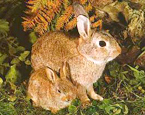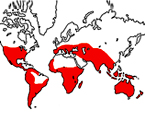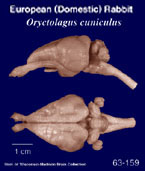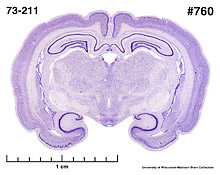|
European
(Domestic) Rabbit
(Oryctolagus cuniculus) #73-211 |
||||
|
|
Physical
characteristics and distribution
|
|
The
European (Domestic) Rabbit is the ancestral form of all domesticated
rabbit breeds. It is 35-45 cm in length and has short ears
tipped with a black spot. The limbs are short and the weight
is 1-2 kg. The fur is gray with white highlights on the back
and the underside is white. The lower part of the tail is
also white. European
(Domestic)Rabbits
prefer to feed on grasses and herbaceous plants but will also
eat bark and twigs if grass is not available. The European (Domestic) Rabbit originated in W and S Europe through th Mediterranean region to Morocco and N Algeria; later introduced on all continents except Antarctica and Asia. Now found worldwide as domesticated forms. |
|
Description
of the brain
|
|
Animal
source and preparation
|
|
All
specimens collected followed the same preparation
and histological procedure.
|
Other Related Resources (websites and publications)
List of Specimens | Explore Collections | Brain Sections | Brain Evolution | Brain Development | Brain Circuitry | Brain Functions | Location and Use | Related Web Sites | Contact Us | Search MSU Database | Personnel | Home



